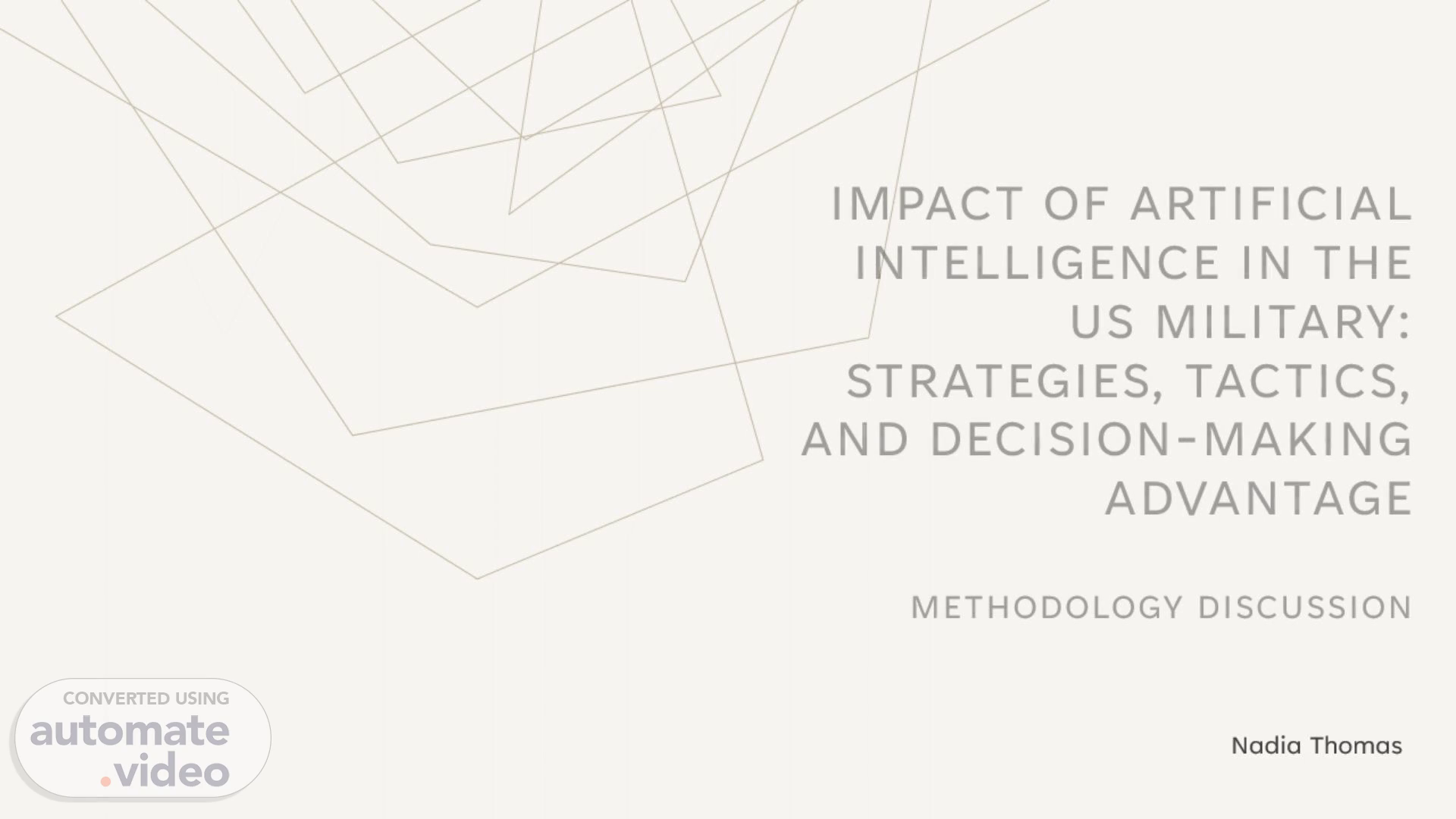
Impact of Artificial Intelligence in the US Military: strategies, tactics, and decision-making advantage Methodology Discussion
Scene 1 (0s)
[Audio] Greetings, fellow classmates, Dr. Perry. My name is Nadia Thomas, and my thesis is on the impact of artificial intelligence and AI-enabled technologies on the U.S. military regarding strategies, tactics, and decision-making. This brief is to address the methodology surrounding my capstone thesis.
Scene 2 (21s)
[Audio] The following brief will provide a deep overview of the research design, variables, measurements data collection, treatment procedures, data analysis and assessment, and conclusion into how artificial intelligence and AI-enabled technology affect the United States military decision-making for employment use in the battlespace..
Scene 3 (41s)
[Audio] Recent advances in artificial intelligence and technologies suggest increased military power, strategic competition, and advantage on the battlefield. This paper examines the role of Artificial Intelligence (AI)-enabled technologies in the United States (U.S.) military. The U.S. military leverages AI in autonomous surveillance tools, weapons systems, cybersecurity and threat monitoring, and combat simulation training. Joint Force operations rely on data-driven advancements to implement reform across multi-domains. This study incorporates evidence from current government regulations, policies, doctrine, and scholarly publications, demonstrating that AI-enabled technologies are used in the U.S. military to enhance decision-making capabilities. As military forces and allied services move toward a common operating picture, successes must affect all domains. Ethical considerations are evident in the use of such technological advances. The purpose of this paper is to conduct research using current U.S. Government regulations, policies, doctrine, and other scholarly publications that will enable the exploration of the current capabilities of artificial intelligence as a rapidly growing technological advancement, identify how artificial intelligence (AI)-enabled technology enhances capabilities in the military by improving decision-making, the potential implications for effectiveness through the examination of ethical considerations, and how the continuous expansion could considerably alter future battlespace, giving the United States military more calculated advantage..
Scene 4 (2m 21s)
[Audio] This paper will use mixed-methods research to examine the impact of artificial intelligence (AI) in the United States military. The paper will research how AI supports strategic and tactical operations and its potential to influence decision-makers. Quantitative research will identify the number of AI tools and systems currently used in the battlespace and how they enhance military tactics, autonomous weapons, and human-machine analysis. Qualitative research will be used to compare leaders' perspectives from various nations on how AI transforms the battlespace for their respective countries..
Scene 5 (3m 0s)
[Audio] Research using AI-enabled technology in the U.S. military requires dependent and independent variables. The performance and use of AI-enabled technology in the military and its use can be labeled dependent variables, as both rely on independent variables. Some of the independent variables of the use of AI-enabled technology in the military consist of the following: The level of autonomy as it relates to the ability to keep a human in the loop The large amount of data it takes to create machine learning to improve performance constructively The quality of training and testing in the workforce to ensure functionality is met Ethical considerations related to the use of AI-enabled technologies in the military, resulting in unmanned and autonomous weapons systems firing, causing catastrophic effects.
Scene 6 (3m 55s)
[Audio] This paper will use secondary sources to include U.S. Government regulations, policies and doctrine, Analysis from case studies, and other scholarly publications..
Scene 7 (4m 8s)
[Audio] This paper will consist of secondary data collection of preexisting research into AI-enabled technology in the military. The key reason to leverage preexisting research on this topic is the deep records of research and development of advancements. The Department of Defense has dedicated a multitude of research and development (R&D) funds to discover the impact of Artificial Intelligence in the effort to defend the homeland. Such research will enable the testing of the hypothesis..
Scene 8 (4m 40s)
[Audio] This research will be aligned in themes to encourage ease of reading and enable the reader to follow the macro to micro case studies on AI-enabled technologies and their impact on the Department of Defense..
Scene 9 (4m 53s)
[Audio] Through the collected data, this paper will show how the military can leverage AI-enabled technology to improve data analysis, equipment availability and readiness, data management and governance initiatives, predictive maintenance, supply and inventory forecasting, optimizing tactical and technical proficiency, and even using prescriptive analytics to inform better the selection of individuals for school seats and career progression. The Pentagon's 2023 Data, Analytics, and Artificial Intelligence Adoption Strategy aims to accelerate the adoption of advanced artificial intelligence capabilities to ensure U.S. warfighters maintain decision superiority on the battlefield for years. The interpretation of this strategy, among other strategic documents, will provide a more agile approach to AI development and application, emphasizing speed of delivery and adoption at scale, leading to five specific decision advantage outcomes: Superior battlespace awareness and understanding, Adaptive force planning and application, Fast, precise and resilient kill chains, Resilient sustainment support, and Efficient enterprise business operations..
Scene 10 (6m 1s)
[Audio] In conclusion, Artificial Intelligence (AI) can potentially revolutionize how militaries operate worldwide. With the global integration of AI-enabled technologies to create a common operating picture, the U.S. military will improve decision-making power, situational awareness, and reduction of risks. The U.S. military already leverages these advanced technologies through autonomous systems, data analysis, and cybersecurity. The potential to improve decision-making for combat effectiveness will continue to grow, making the military more agile and efficient. However, with the rest of the world in the same race to stay ahead of other military competitors, the U.S. military must ensure a position in the front of the challenge. The U.S. government continues to focus on the ethical and legal constraints set forth to maintain this steady state. The potential benefits are vast, and the Defense Innovation Board insists on government principles to establish ethical boundaries that must be addressed..
Scene 11 (7m 7s)
[Audio] Thank you for listening, and I look forward to your feedback..